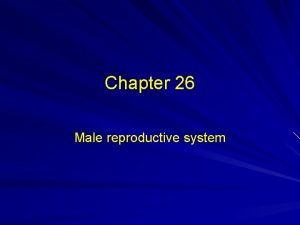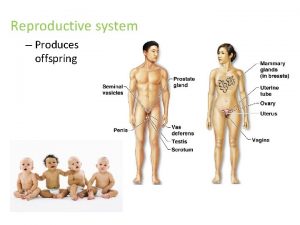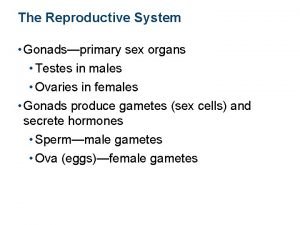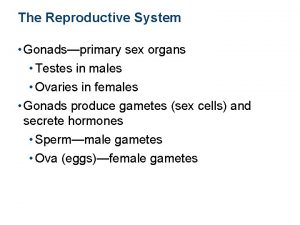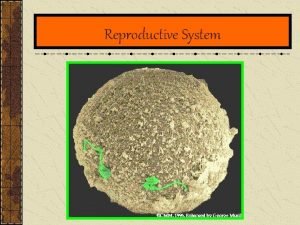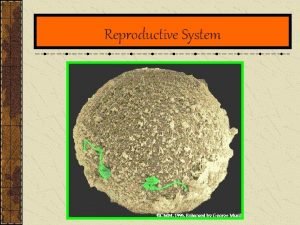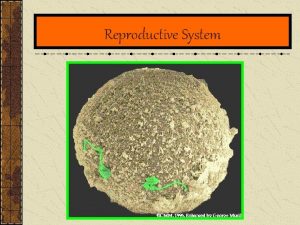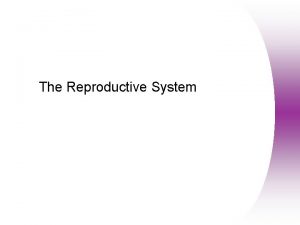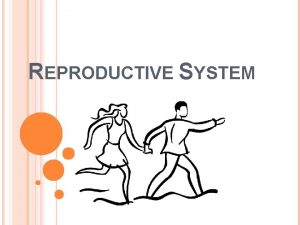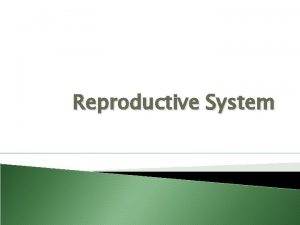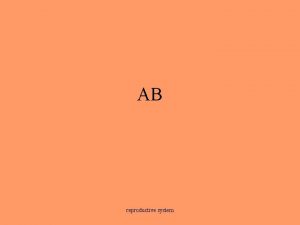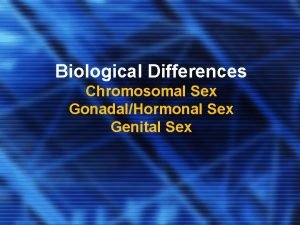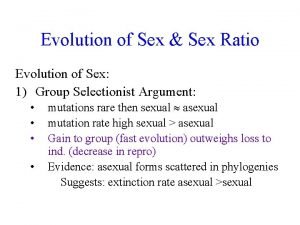The Reproductive System The Reproductive System Gonadsprimary sex















































- Slides: 47

The Reproductive System

The Reproductive System • Gonads—primary sex organs – Testes in males – Ovaries in females • Gonads produce gametes (sex cells) and secrete hormones – Sperm—male gametes – Ova (eggs)—female gametes

Male Reproductive System Overview • Testes • Duct system – Epididymis – Ductus (vas) deferens – Urethra

Male Reproductive System Overview • Accessory organs – Seminal vesicles – Prostate – Bulbourethral glands • External genitalia – Penis – Scrotum

Male Reproductive System Figure 16. 2 a

Male Reproductive System Figure 16. 2 b

Testes • Coverings of the testes – Tunica albuginea—capsule that surrounds each testis – Septa—extensions of the capsule that extend into the testis and divide it into lobules

Testes Figure 16. 1

Testes • Each lobule contains one to four seminiferous tubules – Tightly coiled structures – Function as sperm-forming factories – Empty sperm into the rete testis (first part of the duct system) • Sperm travels through the rete testis to the epididymis • Interstitial cells in the seminiferous tubules produce androgens such as testosterone

Testes Figure 16. 1

Duct System • Epididymis • Ductus (vas) deferens • Urethra

Epididymis • Comma-shaped, tightly coiled tube • Found on the superior part of the testis and along the posterior lateral side • Functions to mature and store sperm cells (at least 20 days) • Expels sperm with the contraction of muscles in the epididymis walls to the vas deferens

Epididymis Figure 16. 1

Ductus Deferens (Vas Deferens) • Carries sperm from the epididymis to the ejaculatory duct • Passes through the inguinal canal and over the bladder • Moves sperm by peristalsis • Spermatic cord—ductus deferens, blood vessels, and nerves in a connective tissue sheath

Ductus Deferens (Vas Deferens) Figure 16. 1

Ductus Deferens (Vas Deferens) • Ends in the ejaculatory duct which unites with the urethra • Expanded end is called the ampulla • Ejaculation—smooth muscle in the walls of the ductus deferens create peristaltic waves to squeeze sperm forward • Vasectomy—cutting of the ductus deferens at the level of the testes to prevent transportation of sperm

Urethra • Extends from the base of the urinary bladder to the tip of the penis • Carries both urine and sperm • Sperm enters from the ejaculatory duct

Urethra • Regions of the urethra – Prostatic urethra—surrounded by prostate – Membranous urethra—from prostatic urethra to penis – Spongy (penile) urethra—runs the length of the penis

Urethra Figure 16. 2 b

Accessory Organs • Seminal vesicles • Prostate • Bulbourethral glands

Accessory Organs Figure 16. 2 b

Seminal Vesicles • Located at the base of the bladder • Produces a thick, yellowish secretion (60% of semen) – Fructose (sugar) – Vitamin C – Prostaglandins – Other substances that nourish and activate sperm

Accessory Organs Figure 16. 2 b

Prostate • Encircles the upper part of the urethra • Secretes a milky fluid – Helps to activate sperm – Enters the urethra through several small ducts

Prostate

Bulbourethral Glands • Pea-sized gland inferior to the prostate • Produces a thick, clear mucus – Cleanses the urethra of acidic urine – Serves as a lubricant during sexual intercourse – Secreted into the penile urethra

Bulbourethral Glands

Semen • Mixture of sperm and accessory gland secretions • Advantages of accessory gland secretions – Fructose provides energy for sperm cells – Alkalinity of semen helps neutralize the acidic environment of vagina – Semen inhibits bacterial multiplication – Elements of semen enhance sperm motility

External Genitalia • Scrotum • Penis

External Genitalia Figure 16. 2 a

External Genitalia • Scrotum – Divided sac of skin outside the abdomen – Maintains testes at 3°C lower than normal body temperature to protect sperm viability

External Genitalia • Penis – Delivers sperm into the female reproductive tract – Regions of the penis • Shaft • Glans penis (enlarged tip) • Prepuce (foreskin) – Folded cuff of skin around proximal end – Often removed by circumcision

External Genitalia Figure 16. 2 a

External Genitalia • Internally there are three areas of spongy erectile tissue around the urethra • Erections occur when this erectile tissue fills with blood during sexual excitement

Spermatogenesis • Production of sperm cells • Begins at puberty and continues throughout life • Occurs in the seminiferous tubules

Spermatogenesis Figure 16. 3

Spermatogenesis • Spermatogonia (stem cells) undergo rapid mitosis to produce more stem cells before puberty • Follicle-stimulating hormone (FSH) modifies spermatogonia division – One cell produced is a stem cell, called a type A daughter cell – The other cell produced becomes a primary spermatocyte, called a type B daughter cell

Spermatogenesis • Primary spermatocytes undergo meiosis • One primary spermatocyte produces four haploid spermatids – Spermatids— 23 chromosomes (half as much material as other body cells)

Human Life Cycle • Union of a sperm (23 chromosomes) with an egg (23 chromosomes) creates a zygote (2 n or 46 chromosomes)

Human Life Cycle Figure 16. 4

Spermiogenesis • Late spermatids are produced with distinct regions • Head • Midpiece • Tail – Sperm cells result after maturing of spermatids • Spermatogenesis (entire process, including spermiogenesis) takes 64 to 72 days

Structure of a Sperm Figure 16. 5 b

Structure of a Sperm Figure 16. 5 a

Anatomy of a Mature Sperm Cell • The only human flagellated cell • Head – Contains DNA – Acrosome—“helmet” on the nucleus, similar to a large lysosome – Breaks down and releases enzymes to help the sperm penetrate an egg • Midpiece – Wrapped by mitochondria for ATP generation

Testosterone Production • The most important hormone of the testes • Produced in interstitial cells • During puberty, luteinizing hormone (LH) activate the interstitial cells • In turn, testosterone is produced

Testosterone Production • Functions of testosterone – Stimulates reproductive organ development – Underlies sex drive – Causes secondary sex characteristics • • Deepening of voice Increased hair growth Enlargement of skeletal muscles Thickening of bones

Hormonal Control of the Testis Figure 16. 6
 Sex sex sex
Sex sex sex Snv sex
Snv sex Xxtesticles
Xxtesticles Sex sex sex
Sex sex sex Sex sex sex
Sex sex sex Primary sex organ of the male reproductive system? *
Primary sex organ of the male reproductive system? * Linkage
Linkage What is sex linkage in biology
What is sex linkage in biology Sex determination and sex linkage
Sex determination and sex linkage Once a sex offender always a sex offender
Once a sex offender always a sex offender Ovary duct
Ovary duct Endocrine system and reproductive system
Endocrine system and reproductive system Hát kết hợp bộ gõ cơ thể
Hát kết hợp bộ gõ cơ thể Frameset trong html5
Frameset trong html5 Bổ thể
Bổ thể Tỉ lệ cơ thể trẻ em
Tỉ lệ cơ thể trẻ em Voi kéo gỗ như thế nào
Voi kéo gỗ như thế nào Tư thế worm breton
Tư thế worm breton Chúa sống lại
Chúa sống lại Các môn thể thao bắt đầu bằng từ đua
Các môn thể thao bắt đầu bằng từ đua Thế nào là hệ số cao nhất
Thế nào là hệ số cao nhất Các châu lục và đại dương trên thế giới
Các châu lục và đại dương trên thế giới Công thức tính thế năng
Công thức tính thế năng Trời xanh đây là của chúng ta thể thơ
Trời xanh đây là của chúng ta thể thơ Cách giải mật thư tọa độ
Cách giải mật thư tọa độ Làm thế nào để 102-1=99
Làm thế nào để 102-1=99 Phản ứng thế ankan
Phản ứng thế ankan Các châu lục và đại dương trên thế giới
Các châu lục và đại dương trên thế giới Thơ thất ngôn tứ tuyệt đường luật
Thơ thất ngôn tứ tuyệt đường luật Quá trình desamine hóa có thể tạo ra
Quá trình desamine hóa có thể tạo ra Một số thể thơ truyền thống
Một số thể thơ truyền thống Cái miệng bé xinh thế chỉ nói điều hay thôi
Cái miệng bé xinh thế chỉ nói điều hay thôi Vẽ hình chiếu vuông góc của vật thể sau
Vẽ hình chiếu vuông góc của vật thể sau Biện pháp chống mỏi cơ
Biện pháp chống mỏi cơ đặc điểm cơ thể của người tối cổ
đặc điểm cơ thể của người tối cổ V cc cc
V cc cc Vẽ hình chiếu đứng bằng cạnh của vật thể
Vẽ hình chiếu đứng bằng cạnh của vật thể Vẽ hình chiếu vuông góc của vật thể sau
Vẽ hình chiếu vuông góc của vật thể sau Thẻ vin
Thẻ vin đại từ thay thế
đại từ thay thế điện thế nghỉ
điện thế nghỉ Tư thế ngồi viết
Tư thế ngồi viết Diễn thế sinh thái là
Diễn thế sinh thái là Dạng đột biến một nhiễm là
Dạng đột biến một nhiễm là So nguyen to
So nguyen to Tư thế ngồi viết
Tư thế ngồi viết Lời thề hippocrates
Lời thề hippocrates Thiếu nhi thế giới liên hoan
Thiếu nhi thế giới liên hoan





